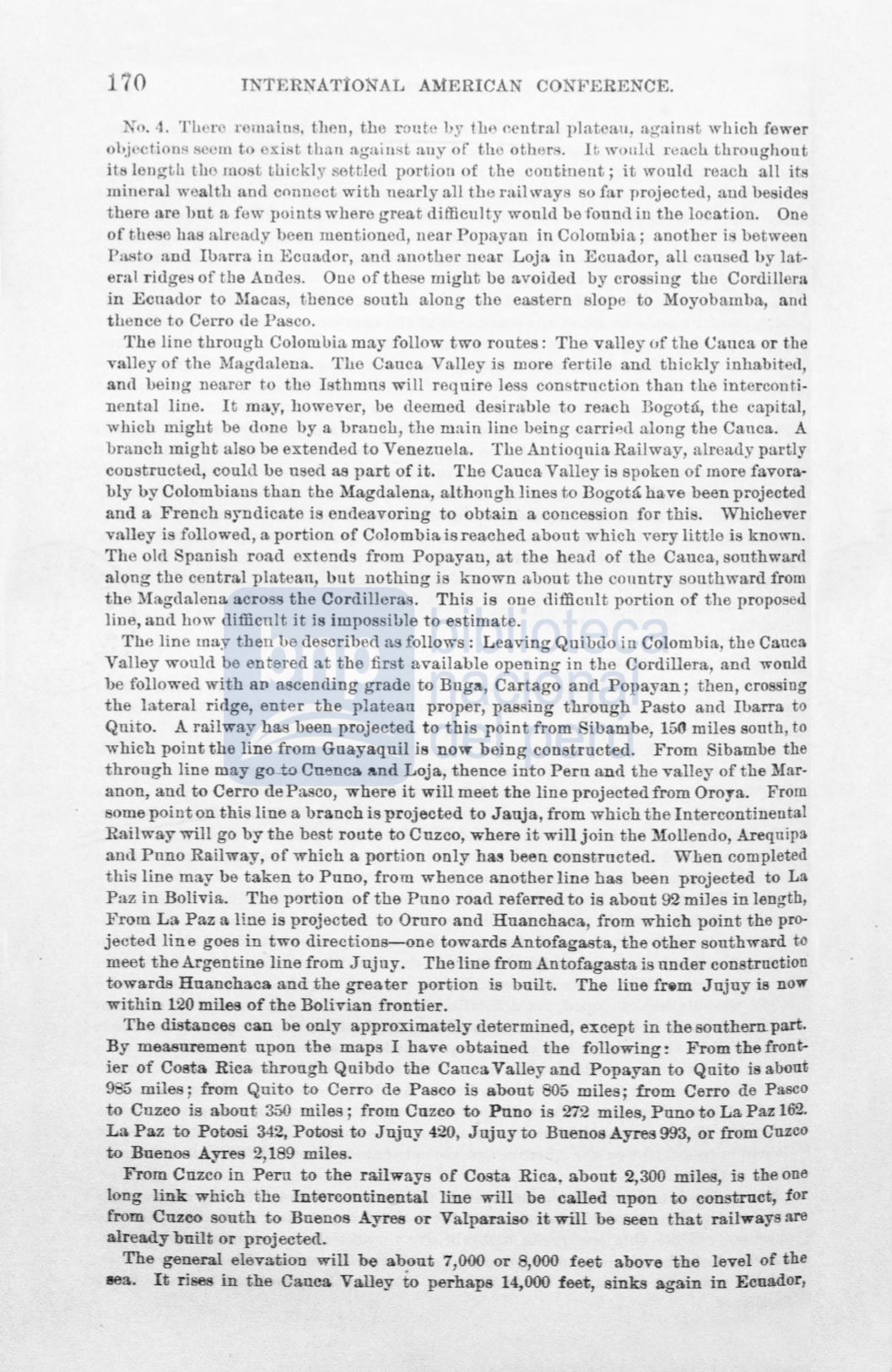

70
IN'l'ERNATÍO~AL
AMERICAN CO ,.FERENCE.
No. 4. TbPrc remainR, thfln, the rente
by
thA neutral })httea11, againRt wbich fewer
ol•jPct iom; scem to .xist than against auy of thc otht1r. .
lt
wo1tlü
rt:~ach
throughout
it !ength
tlw
rnost thickly settled portiou of the couti-nent; it would
rea.chall its
mineral wealtb and connect wi th nearly all the rail ways so far T'rojected, and beside
tbere are 1mt a few points where great difficulty would be found iu the location. One
of these has already been ment ioned, near Popa.yan in Colombia; another is between
PaRto and !barra in Ecuador, and another ncar Loja in Ecuador, all caused by l:J.t–
eml ridges of tbe Andes. One of these might be avoided by crossing the Cordillera
in Ecuador to .Macas, tbeuce south along the eastern slope to Moyobamba, and
t hence to CetTO ue Paseo.
The line through Colombia ma.y follow two routes: The valley
úf
the Canea or the
valley of the Magdalena. The Canea Valley is more fertile and thickly iuhabited,
a.ndbeing nearer to the Istbmus will req uire less construction tban t he interconti–
n ental line.
It
may, however, be deemed desimble to reach Bogotá, the capital,
which might be done by a branch, the main lino beiug carrifld along the Canea. A
b ranch might also be extended to Venezuela. The AntioquiaRailway, already p:utly
constructed, coulU be used as part of it. The CaneaValley is spoken of more favora–
bly by Colombiana than the Magdalena, althongh lines to Bogotá have been projeoted
and a French syndicate is endeavoring to obtain a coucession for this. Whicbever
valley is followed,
a.
portion of Colombia is reached about which very little is known.
The old Spa.nish road extends from Popayau, at the h eacl of the Canea, southward
along the central platean, but nothing is known about the conntry southward from
the Magdalena across the Cordilleras. This is one difficnlt portion of the proposed
line, and how difficult it is impossible to estimate.
The line may then be described as follows: Leaving Quibüo in Colombia, tbe Canea
Valley would be entered at the first avai1able opening in the Cordillera, and wonld
be followed with
aD
ascending grade to Bug&, Cartago and Popayan; theu, crossing
the l ateral ridge, enter the platean proper, passing through Pasto and !barra to
Quit o. A railway has been projected to this point from Sibambe,
156
miles south, to
which point the line from Guayaquil is now being coustructed. From Sibambe the
through line may gO-±o Cuenca And Loja, thence iuto Peru and the valley of the Mar–
anon, and
to
Cerro de Paseo, where it will meet the line projectedfrom Oroya. From
somepointon thisline a brauch isprojected to Jauja, from which tbe Intercontinental
Railway will go by the best route to Cuzco, where it will join the Moliendo, Arequipa
and Puno Railway, of which a portion ouly has been constructed. Wben completad
this line may be taken to Puno, from whence another line has beeu projected to La
P az in Bolivia. The portiou of the Puno road referred to is about 92 miles in length,
From La Paz a line is projected to Oruro and Huanchaoa, from which point the pro–
jected line goes in two directions- one towards Antofagasta, the other southward to
meet the Argentina line from J uj uy. Theline from
An
tofagasta
is
under coustrnction
towards Hnanohaoa and the greater portion is built. The line frem Jnjuy is now
within
120
miles ofthe Bolivian frontier.
The distances can be ouly approximately determinad, except in the southern.part.
By measurement npon tbe maps I have obtained the following: From the front–
ier of Costa Rica through Quibdo the Canea Valley and Popayan to Quito is abont
985 miles; from Quito to Cerro de Paseo is about
805
miles; from Cerro de Paseo
to Cuzco is a.bout 350 miles; from Cnzco to Puno is 272 miles, Puno toLa Paz
162.
La Paz
to
Potosi 342, Potosi to Jujuy 420, Jujuy
to
Buenos Ayres 993, or from Cuzco
to
Buenos Ayr-es
2,189
miles.
From Cuzco in Peru to the railways of Costa Rica, about 2,300 miles, is the one
long link wbich the Intercontinental line will be called npon to constrnct, for
from Cnzco south
to
Buenos Ayres or Valparaiso it will
be
sean that railways
are
already built or projected.
The general elevation will be about 7,000 or 8,000 feet above the level of the
~~ea.
It
rises in the Canea Valley to perhaps
14,000
feet, sinks again in Ecuador,
















